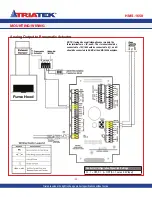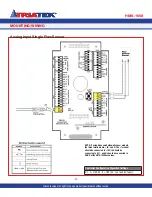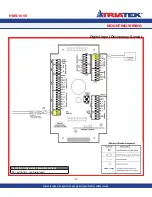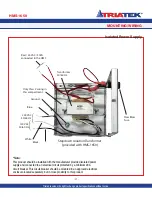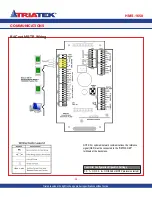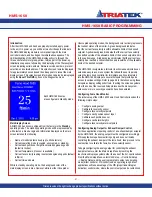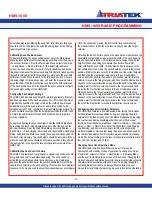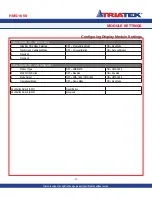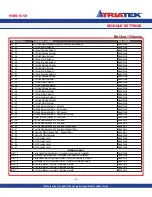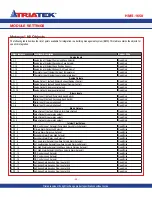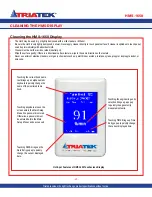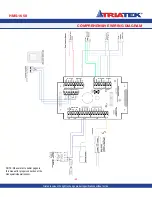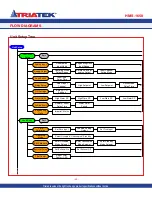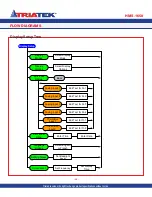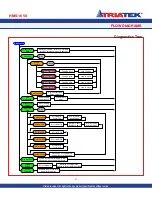
Due to continuous improvement, Triatek reserves the right to change product specifications without notice.
HMS-1650 BASIC PROGRAMMING
HMS-1650
-
34
-
Mode
selection popup. Also, if the fume hood controller is in
Standby
mode
, the
OCCUPIED
button at the bottom of the main display may be
used to directly switch to the Occupied operating mode.
Changing Network Settings
Changing network settings on the FMS-1650 is extremely simply
and can be accessed by selecting
Unit Setup
-->
Network Setup
.
Depending upon the protocol selected, the
Network Setup
menu will
present the user with the available options. All HMS-1650 demo units
have a default protocol selection of BACnet, and therefore the
Network
Setup
menu options pertain to this protocol. From this menu, the user
can select a different baud rate or change the network address of the
unit.
Adding Password Security
The HMS-1650 menu system can be protected by adding up to ten
(10) multi-level passwords to the system. A password entry may be
created by selecting
System Setup
-->
Next
-->
Passwords Setup
-->
Add Password
and the user is prompted to enter a minimum of four
(4) and up to eight (8) digits. Once a password has been specified,
the user is prompted to specify one of four access levels:
Unrestricted
,
Standard
,
Basic
, and
Restricted
. All password entries are saved to
non-volatile memory. In the event that a password has been forgotten,
there is a factory-default “back door” password that will provide
unrestricted access to the user menu system. Please consult with the
factory for more information regarding this password.
Changing Display Settings
The HMS-1650 display screen can be customized very easily using
options available under the
Display Setup
menu. For those applications
where the user or customer wants to minimize or eliminate the verbose
text shown on the main display screen, a status-only display mode
may be enabled by selecting
Display Setup
-->
Display Modes
, and
choosing the
Status-Only
option. This mode suppresses all of the
information on the main display screen, leaving only the background
color to indicate status. A green screen indicates normal operating
differential pressure range. A yellow screen indicates that either the
monitored door is opened or the differential pressure is operating in the
warning range. A red screen indicates that the differential pressure has
crossed into the critical operating range.
If the user does not want to completely suppress all information on
the main display screen, specific information may be individually
suppressed by selecting
Display Setup
-->
Display Options
, and
deselecting the status information that should be disabled. For those
customers who need support for multiple languages, the
Language
Options
selection allows the user to change the language displayed
in the menu system and on the main display screen. Changing the
time and date can be accomplished either by using the hotspots on
the main display screen, or by selecting
Display Setup
-->
Set Time &
Date
. The time and date settings are dynamic and do not get saved to
non-volatile memory on the demo unit. Operational units connected to
a controller, however, can retain their time and date settings for up to
two hours with no power connected. Finally, the brightness of the LED
backlighting on the HMS-1650 can be adjusted by selecting
Display
Setup
-->
Next
-->
Set Brightness
. The brightness settings are saved in
nonvolatile memory and remain in effect through a power cycle.
Built-in Diagnostics
The HMS-1650 incorporates several very useful diagnostic tools that
may greatly facilitate diagnosing and troubleshooting the system
during the installation and commissioning phase. The Overrides option
allows both analog and relay outputs to be overridden individually.
Each analog output may be locked at the overridden percentage while
test and balance makes adjustments to supply or exhaust dampers,
for example. While in the overridden state, the analog output is
“disconnected” from its PID control loop, if enabled. Cancelling the
override effectively resumes the normal PID control loop operation,
again if enabled.
A unique feature of the HMS-1650 is the Real-Time View option, which
allows the user to see in real-time the actual inputs and outputs, along
with their voltage levels or states. One of the most useful tools for fine-
tuning the PID loop performance is the Analog I/O Pairs screen, which
displays the analog input and its current setpoint, along with the analog
output which is mapped to it. This allows the user to see in real-time
the varying analog input signal and its corresponding analog output
control signal.
To preserve the configuration settings after verifying that everything
is configured properly, the Save Settings option on the Diagnostics
menu will take a snapshot of the current configuration settings for
later retrieval. In the event that some of the configuration settings
inadvertently get overwritten with invalid settings, typically through
unauthorized operator error, they may be restored either to the
previously saved user settings or to the factory-default settings.
Triatek reserves the right to change product specifications without notice.
Triatek reserves the right to change product specifications without notice.

